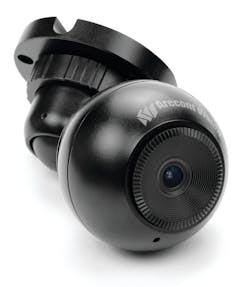The ASIS show floor is dotted with video innovation in the high definition market. From the world’s smallest varifocial lens, to controlling a VMS with the flick of the wrist, there was plenty of innovation to go around on the Philadelphia show floor. Here's a look at a handful of the innovations I saw on my Monday ASIS journey.
Avigilon kicked off the show on Monday with a press conference touting its new Control Center 5.0 video management system, which features a new, cleaner user interface, an intelligent virtual matrix for video walls and enterprise server management functions. However, we got a real glimpse of the future of VMS when Andrew Martz, the company's VP of engineering, started controlling the VMS functions just by flicking his wrist at the screen. As a sampling of what the future may hold for the technology, Martz and his engineering team -- which he said includes a few former video game developers -- wrote a driver for the xbox connect; so, instead of using the device to play video games, it was used to control a VMS with both hand gestures and voice commands. Even with a few glitches, it brought to mind the scene in the famous surveillance-related movie Minority Report, where Tom Cruise is reconstructing footage just by moving his hand in front of a screen. The only thing that was missing was the accompanying chamber music.
Arecont Vision’s latest, the megaball camera, is available in 1.3, 3 and 5 megapixels, and really gives the dome camera a new, sleeker look and feel. The cameras don’t require the ubiquitous glass/plastic dome that most of us in the surveillance industry have grown accustomed to; and they look so modern, they could be legitimately mistaken for a cool-looking lighting fixture, for instance. The company also gave show-goers a glimpse into the future, displaying a 40 megapixel panoramic camera that wont be released for another year, according to senior VP of marketing Raul Calderon. The 40 megapixels will be available in 180- and 360-degree versions; although there will also be 8-, 12- and 20MP models.
Axis Communications broke new ground with its Lightfinder technology about a year ago, enabling users to see great detail despite dark conditions. Now, Lightfinder is available in HDTV format. “This is what people were looking for,” said Fredrik Nilsson, the company’s general manager for the Americas. What might have generated more show buzz, however, might have been the new Axis Camera Companion 1.2 – the second generation of the product and an ASIS Accolades winner that can deliver the benefits of HDTV to smaller systems (16 cameras or less). The software can now support audio, public view cameras and more, and is bringing HDTV into the SMB market.
Panasonic showcased its i-PRO SmartHD 360-degree panoramic 3.0 megapixel dome camera, which combines 1080p HD resolution with numerous features. But beyond high definition, the company focused a lot of its presentation on focus – actually how to improve contrast and keep drops of water off the surface of a dome camera. Dynamic Tone Curve Correction is a firmware upgrade for the company’s cameras that provides automatic contrast correction to improve visibility for low-contrast images typical in adverse weather conditions like fog and sandstorms, salesman Aaron Saks explained. He went on to demo a specialized dome coating that prevents rain drops from accumulating on dome surfaces – sort of a “rain-x” for a camera, for you car wash enthusiasts out there.
At Sony, the news focused on creating custom security surveillance solutions using the company’s new IPELA Engine EX architecture, a common development platform for dome PTZ and bullet cameras. “This adds the technical infrastructure to find a cost-effective way to realize a security vision,” company spokesperson Carl Lindemann explained. Cameras built on the IPELA Engine platform are a key element of the company’s focus on providing full security solutions, including those for emerging areas like business intelligence. The company released six new cameras based on the new architecture. Sony has also teamed with Next Level Security Systems to jointly deliver a cloud-based surveillance solution, where Sony will use NLSS’ peer-to-peer technology to automatically detect available bandwidth to maximize video transmission and viewing.
The world’s smallest varifocal lens was on display at IQinVision, which gives installers flexibility because it only needs one lens. “Most installers just buy 2 or 3 lenses right off the bat so they have them on hand as backup lenses when the end-user decides something should be changed,” marketing manager Wendi Burke explained. The camera is really small and is therefore designed primarily for discreet applications. The lens can display up to 1.3MP resolution.
Verint showed how it can display HD video on regular monitors with its Nextiva High-Definition Receiver, which provides a decoder/receiver approach that enables users to deploy the solution on off-the-shelf workstations. The software can be deployed across multiple screens to deliver high-performance video display capabilities and support multiple frame rates, resolutions and number of tiles/monitors. The company also announced Nextiva Mobile, which enables users to control the company’s VMS to view live and recorded video on Apple-brand mobile devices.
Samsung is aiming to bring high definition to small and medium enterprises with its value line of 1.3 and 3MP cameras. Contrast enhancement and software-based day/night operation enable the cameras to accommodate challenging light conditions. A smart codec helps the cameras reduce the network bandwidth necessary. The company also highlighted a new NVR and a partnership with video storage provider Pivot3.
For more video surveillance product news from ASIS, check out www.securityinfowatch.com/asis2012.







